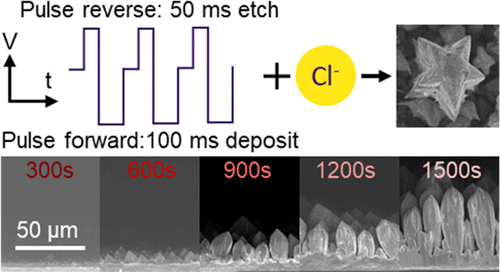当前位置:
X-MOL 学术
›
ACS Appl. Electron. Mater.
›
论文详情
Our official English website, www.x-mol.net, welcomes your
feedback! (Note: you will need to create a separate account there.)
Electrodeposited Copper Micropillar Surfaces with Pulse Reverse Voltammetry for Enhanced Heat Dissipation
ACS Applied Electronic Materials ( IF 4.3 ) Pub Date : 2020-03-18 , DOI: 10.1021/acsaelm.0c00068 Jayce JW Cheng 1 , FengXia Wei 1 , Sing Yang Chiam 1
ACS Applied Electronic Materials ( IF 4.3 ) Pub Date : 2020-03-18 , DOI: 10.1021/acsaelm.0c00068 Jayce JW Cheng 1 , FengXia Wei 1 , Sing Yang Chiam 1
Affiliation

|
Microstructured metal coatings are promising for many commercial applications due to their robustness, high thermal and electrical conductivities, and interesting functionalities. In particular, copper electrodeposition has been widely studied due to its low cost and scalability while maintaining excellent material quality. Here, we use pulse electrodeposition to simultaneously monitor and generate copper microstructures on copper and aluminum surfaces. By rapidly applying forward and reverse potentials, we identify a key metric—the ratio of deposition to etching—that has a characteristic temporal profile for four different growth regimes: thin films, pyramids, micropillars, and dendrites. We explore the parameter space by varying the forward voltage between 100 and 500 mV and added chloride between 100 and 1000 ppm to transition the microstructure between these four growth regimes, allowing us to obtain the desired surface structure. With this capability, we deposit micropillar arrays on large-area copper and aluminum heat sink surfaces, yielding performance enhancements of 10 and 4%, respectively, showing that such coatings are promising for thermal management applications.
中文翻译:

脉冲反向伏安法电沉积铜微柱表面以增强散热
微结构金属涂层由于其坚固性,高导热性和导电性以及令人感兴趣的功能性而在许多商业应用中很有希望。特别地,由于铜电沉积的低成本和可扩展性,同时保持优异的材料质量,因此已被广泛研究。在这里,我们使用脉冲电沉积同时监测和生成铜和铝表面上的铜微结构。通过快速施加正向和反向电位,我们确定了一个关键指标(沉积与蚀刻的比率),该指标在四个不同的生长机制(薄膜,金字塔,微柱和树突)中具有特征性的时间分布。我们通过在100至500 mV之间改变正向电压和在100至1000 ppm之间添加氯化物以在这四个生长方式之间转变微观结构,从而探索参数空间,从而使我们能够获得所需的表面结构。借助这种功能,我们将微柱阵列沉积在大面积的铜和铝散热器表面上,分别使性能提高了10%和4%,这表明此类涂层在热管理应用中很有希望。
更新日期:2020-03-18
中文翻译:

脉冲反向伏安法电沉积铜微柱表面以增强散热
微结构金属涂层由于其坚固性,高导热性和导电性以及令人感兴趣的功能性而在许多商业应用中很有希望。特别地,由于铜电沉积的低成本和可扩展性,同时保持优异的材料质量,因此已被广泛研究。在这里,我们使用脉冲电沉积同时监测和生成铜和铝表面上的铜微结构。通过快速施加正向和反向电位,我们确定了一个关键指标(沉积与蚀刻的比率),该指标在四个不同的生长机制(薄膜,金字塔,微柱和树突)中具有特征性的时间分布。我们通过在100至500 mV之间改变正向电压和在100至1000 ppm之间添加氯化物以在这四个生长方式之间转变微观结构,从而探索参数空间,从而使我们能够获得所需的表面结构。借助这种功能,我们将微柱阵列沉积在大面积的铜和铝散热器表面上,分别使性能提高了10%和4%,这表明此类涂层在热管理应用中很有希望。











































 京公网安备 11010802027423号
京公网安备 11010802027423号